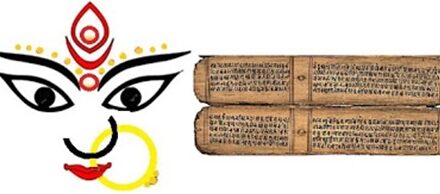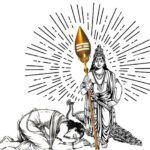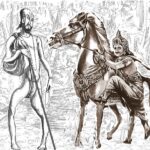
KULA DEVATHA OR TUTELARY/FAMILY DEITIES:
ORIGIN AND CONCEPT
-Santhipriya-
-10-
DIVISION IN WORSHIP -AGAMA AND NON AGAMA-
191. Who were the deities worshipped in the ancient period when divine worship commenced ? The deities, mainly female form of goddesses, associated with the well-being of the villages were either in violent posture or in benevolent ones and worshipped. There was no divisions such as Brahmins and non-Brahmins and everyone in the village worshipped the same deity in the same shrine or worship places which may have been either a Village deity, guardian deity or some unknown divine in the form of stones or spirits.
192. If we carefully analyse the deities worshipped as Kula Devatha or Tutelary/Family deity, they would find that around 85 % of the deities would be in female form- mostly emanations of Goddess Parvathi, hardly 10 % male- emanations of Lord Vishnu or Lord Shiva and 5 % major deities. Lord Vinayaga, Lord Hanuman, Lord Vishnu in his original form, Lord Shiva in original form, Lord Brahma, Goddess Saraswathi, Goddess Mahalakshmi or even Lord Moon, Lord Sun, Lord Saniswarar and Lord Krishna etc have not been worshipped as their Kula Devatha or Tutelary/Family deity in their original form.
193. As the period gained momentum, and with Aryans settled in many places in India, the culture of Brahmanism and Non-Brahmanism began to surface leading to agama form of worship. Some of the deities which were initially non agamic Village deities –worshipped by everyone in the manner they practiced- began to be converted into Agama deities performing the rituals and poojas with Sanskrit mantras and slokas offering only Vegetarian oblations. On the other hand the non-agamic deities were offered non Veg oblation including animal sacrifices, alcohol and meat offerings and Poojas performed in the local languages which existed in those villages. This divide reflected in the worship centers (when bigger temples had not been constructed) becoming Brahmin worship centers and non-Brahmin worship places.
194. While those who believed in the agama style of worship began to accept one group of deities as their Kula Devatha or Tutelary/Family deity, the other group began to worship their own deities as their Kula Devatha or Tutelary/Family deity leading to two main forms of deity propitiated in a village. Thus, two sets of Kula Devatha or Tutelary/Family deity in the villages emerged- one worshipped by Brahmins and the other by non-Brahmins, the worship pattern and offerings were quite different from each other. Even today one can see in the villages two sets of worship centers (temples) even though the deities may be same there, but in different postures.
195. When the Pallava, Chera and Chola Kings took over the reins of the land in vast areas, they slowly built huge temples, which were in the townships for many divines. Even then it was surprising to find that most of the deities enshrined in them became Kula Devatha or Tutelary/Family deity of those living in those areas and they were instrumental in augmenting the worship and faith on divines.
196. Village god and goddesses were viewed as twin personalities. Some were seen to be benevolent, kindly, and would shower blessings on the villages where they were worshipped while others were vengeful and angry, and would unleash terror on the village unless they were propitiated. Generally, it was believed that the male divines called Village deities protected the villages from evils and other dangers including natural calamity, the female divines called Amman or guardian deities were considered to be fertility Goddesses.
197. Strangely the division was reflected even in the sets of prime divines. For example in male divines, many manifestations of Lord Vishnu, Lord Shiva and female goddesses Tripurasundari, Lalithambigai, Kamatchi, Bhavani, Meenakshi who were all emanations of Goddess Parvathi were considered agama family /tutelary deities, while male divines such as Veerabhadra, Bhairava, Muneeswaran, Kathavarayan, Aiyanar and Karuppaswamy all emanations from Lord Shiva and female goddesses like several Mariamman, Yellamma, Pechiamman, Seethaalamma, Paadaalamma, Angala Parameswari, Gangamma, Saptha kannikas etc who were also emanations from Goddess Parvathi were considered non agamic or fertility goddesses or deities. Lord Muruga and his consort Goddess Valli were considered both agamic as well as non-agamic deities.
198. Surprisingly even today many families both Brahmins and non-Brahmins continue to worship many non-agamic deities as their Kula Devatha or Tutelary/Family deity, reason being they were the deities their forefathers had worshipped centuries ago in their native villages and before the divisions of agamic, non-agamic worship emerged after the arrival of Aryans. A majority of the deities worshipped in the villages were female goddesses compared to male divines because the villagers considered the female goddess to be representation of the village itself, rather than simply a guardian deity and believed that some form of Shakti called Adi Shakti or Parasakthi was the primordial force in the universe and therefore the female goddesses called Amman or Mariamman- were emanations from Goddess Parvathi and were responsible for rain, main protector of the village, especially against common diseases like smallpox or dreaded diseases like the then prevailed plague besides guardian deities of cattle or children.
199. And interestingly, the female goddesses were the most accepted family deities of the non-agamic group of folks. Most of the female deities had their own unique origin stories, and many are worshipped only by members of a particular community. There is a huge diversity of worship practices for these deities, depending on the deity’s nature and other local customs.
SIMILARITIES OF WORSHIP OF KULA DEVATHA IN OUTER WORLD
200. “A household deity is a deity or spirit that protects the home, looking after the entire household or certain key members. It has been a common belief in paganism (Paganism is a term first used in the fourth century by early Christians for people in the Roman Empire who practiced polytheism) as well in folklore across many parts of the world. Household deities fit into two types; firstly, a specific deity – typically a goddess – often referred to as a heath goddess or domestic goddess who is associated with the home and health, with examples including the Greek Hestia (an ancient Greek Religion- virgin goddess of health) and Norse Frigg (Goddess in Germanic mythology-associated with marriage, prophecy, clairvoyance and motherhood). The second type of household deities are those that are not one singular deity, but a type, or species of animistic deity, who usually have lesser powers than major deities. This type was common in the religions of antiquity, such as the Lares of ancient Roman religion, the Gashin of Korean shamanism, and Cofgodas of Anglo-Saxon paganism. Household deities were usually worshipped not in temples but in the home, where they would be represented by small idols, amulets, paintings or reliefs. The gods would be treated as members of the family and invited to join in meals, or be given offerings of food and drink (Ref: https://en.wikipedia.org
201. The present universe is dominated with many religions which has multiple sects in each. Naturally there may be several divine forces being worshipped by each religious sects. When looking at the different kinds of theism or belief in deities, the first big question we have to ask is this: how many deities are there? That’s an important question.
202. The Yajurveda mentions that there were 33 Kotis i.e. 330,000,000 divines. (Ref: https://en.wikipedia.org/wiki/Hindu_deities). Another version mention the figure as 33 million Gods i.e. 33,000,000(Ref: https://www.huffpost.com/entry/the-33-million-demigods-o_b_1737207). It is quite possible that the above two figures may include several demi, semi and sub male and female divines, Deva ganas, Angels, Mohinis and Yoginis who were emanations from prime divines on many occasions. It may not have included the deities of other religions since the period in which the Yajur Veda was written, there existed no other religion except Hinduism. However both the figures on divines are contested by some analysts who state that the term 33 koti Gods mentioned by the Vedas have been misinterpreted as 330 million or 33 crore gods where as the 33 koti means 33 categories.
203. One of the analyst said ‘33 Crore Gods is a completely misinterpreted fact due to wrong translation of Vedic Sanskrit by certain foreign scholars. The term ‘trayastrimsati koti’ mentioned in Atharvana Veda, Yajur Veda, and Satapatha-brahmana, is rightly translated as 33 Gods. The term koti in Sanskrit has two meaning, one is ‘type’ and the other is Crore. (Ref : http://www.thenewsnow.co.in/newsdet.aspx?q=7208). Therefore the word Koti might have indicated only the varieties of divines.
204. Another view aired is ‘Throughout recorded history, we can count between 8,000 and 12,000 gods who have been worshiped. But we can only count about 9 different types of gods (based on theological characteristics) who were worshiped. Each modern god also corresponds to one of these types, and 5 of them are of the Hindu type’. (Ref: https://lisbdnet.com/how-many-gods-are-there-in-the-world/).
205. However, the Anthropologists estimate that at least 18,000 different gods, goddesses, and various animals or objects have been worshipped by humans since our species first appeared. Today, it is estimated that more than 80 percent of the global population consider themselves religious or spiritual in some form. (ref: https://www.psychologytoday.com/us/blog/your-brain-food/202107/why-do-humans-keep-inventing-gods-worship) and worship divines of many nature.
206. It is however not known whether the village or guardian deities considered to be divine and worshipped in remote places have also been included or not in any of the recorded list or views aired. Certainly, no of divines worshipped cannot be either 33 crores, or 33 million or even stand at mere 33. Since various versions create confusion, it would be better all of them be ignored and let the factual position be analysed from another angle.
207. As per the census in 2011 there were over 6,40,930 villages spread over the vast land of India alone (Ref: https://testbook.com/question-answer/how-many-villages-are-approximately-there-in-ind–5e1d7f7cf60d5d2d6cf1c8ee). There is not even a single village where some divine is not worshipped. Most of the Village deities differ from one Village to the other. Therefore, even in a fair assessment we can assume that in India alone, 50% of the Villages have some form of divines- accounting to three lakhs i.e 3,00,000- who is worshipped by the locals. This is only an assumption.
208. When we read all versions in pre paras it will become clear that there may be multiple divines in many forms and appearances –say not less than a lakh – in this Universe and are worshipped by different people of different countries, different religious groups, ethnics and others.
209. See another case in Africa where many tribal exist and they worship several divines. Yoruba are probably the best-known West African ethnic culture in the world. In 1989, it was estimated that more than seventy million African and New World peoples practiced one form or another of Yoruba religion. Yoruba religions, inspired by them, are arguably the most widely dispersed West African religions, both in Africa and in the Americas. Yoruba, one of the three major ethnic groups of Nigeria, have the same ethnic and cultural origins even though their geographic dispersal has located them in different modern states. They may also be the most theologically complex West African religions. It is estimated that the Yoruba have a pantheon of as many as six thousand deities. (Ref: https://www.encyclopedia.com/history/news-wires-white-papers-and-books/deities-yoruba-and-fon-religions).
210. Look at another case. Zulu traditional religion in Southern Africa contains numerous deities commonly associated with animals or general classes of natural phenomena. They believe that the ancestors are believed to live in the spirit world unKulunkulu (meaning the greatest of the great) and are regarded as intermediaries between the living and the spirit world and they work hand in hand with God. The Zulu were originally a major clan in what is today Northern KwaZulu-Natal, founded ca. 1709 by Zulu kaMalandela.
211. The ancient Greeks worshipped many gods, each with a distinct personality and domain. Greek myths explained the origins of the gods and their individual relations with mankind.
212. There are approximately 4,300 religions in the world. This information is according to Adherents, an independent, non-religiously affiliated organization that monitors the number and size of the world’s religions. (https://www.theregister.com/2006/10/06/the_odd_body_religion/) Even if one religion have their own divines the count could be not less than 4800.
213. Therefore no one can give conclusive answer to how many divines are worshipped. All that we hear and read are based mere assumptions since in every country, multiple religions worship multiple divines of their own. We can at best remain satisfied that there are multiple divines worshipped in the world whose count cannot be authenticated.
CONCLUDED




